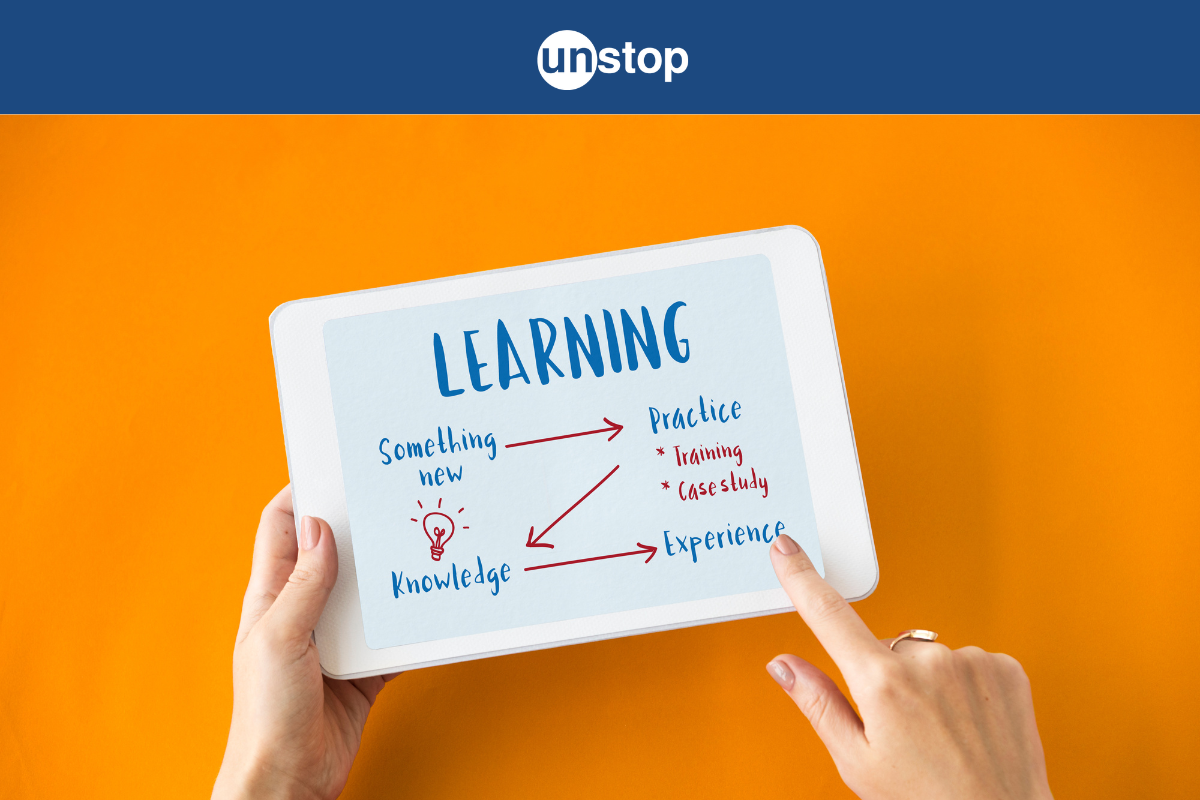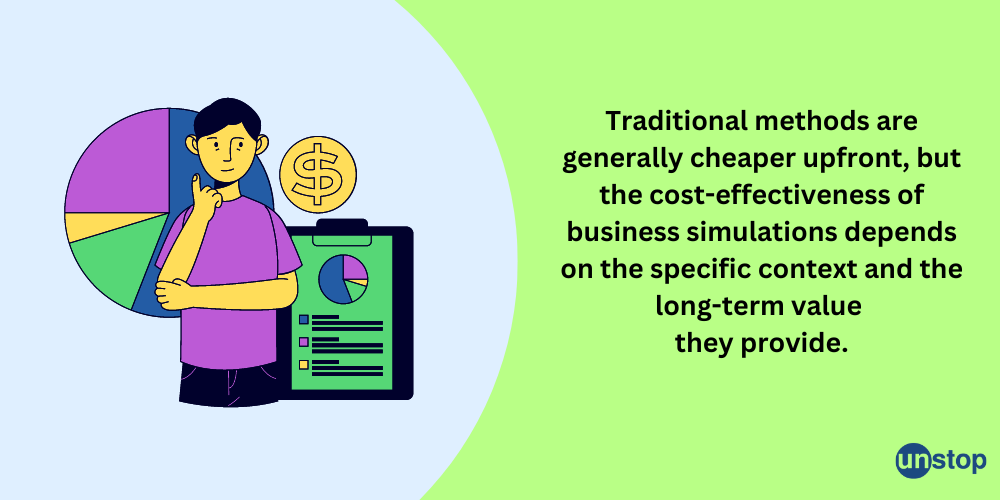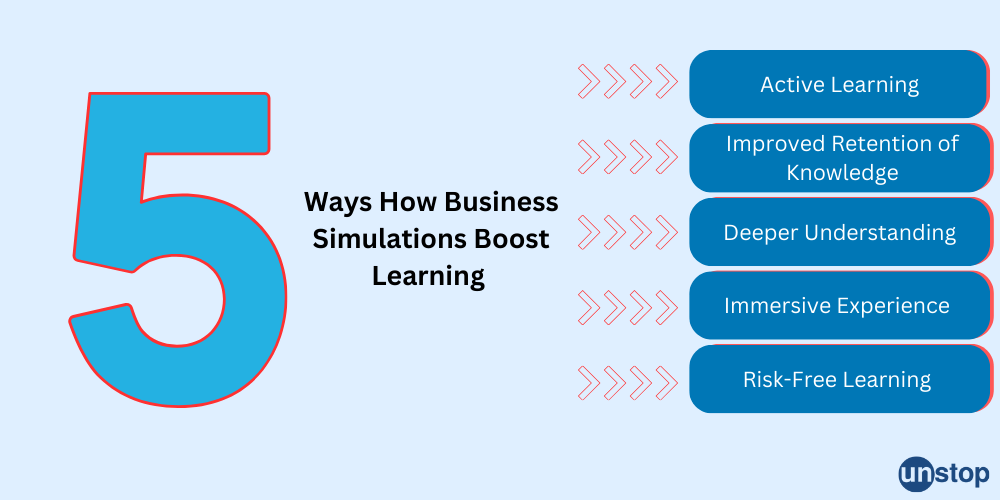- Understanding Business Simulations and Their Purpose
- Difference between Business Simulation and Traditional Methods
- 5 ways business simulations improve learning outcomes
- Conclusion
- Frequently Asked Questions
Five Ways Business Simulations Boost Learning Outcomes

Business simulations have become increasingly popular due to their effectiveness in enhancing learning outcomes. Unlike traditional methods, business simulations provide a practical and engaging learning experience that allows participants to apply their knowledge and skills in a simulated business environment. They offer an opportunity for participants to practice real-life scenarios, learn from competition, identify strengths and weaknesses, and align their actions with the objectives of the company or course. Let's see the ways in which business simulations are able to enhance learning outcomes in trainees.
Understanding Business Simulations and Their Purpose
“I Hear and I Forget, I See and I Remember, I Do and I Understand” - Confucious
Hands-on experience is a valuable learning method that allows individuals to actively engage in a task or activity. It provides the opportunity to apply theoretical knowledge in a practical context, building a deeper understanding of concepts. Hands-on experience enhances problem-solving abilities and promotes critical thinking, making it an essential component of effective learning. To promote hands-on training, business simulations are the most suitable means for most companies.
Through business simulations, learners can explore different strategies, test their ideas, and experience the consequences of their decisions in a safe and controlled environment. This experiential learning approach helps bridge the gap between theory and practice, enabling learners to gain valuable insights into real-world challenges without the risk associated with actual business operations.
A study by Gallup found that employees who felt they had opportunities for hands-on learning were 12% more likely to be engaged in their work!
One of the key benefits of using business simulations is that they create an engaging and interactive learning experience. Through business simulation, learners become active participants rather than passive recipients of information. They have the opportunity to make informed choices, analyze data, collaborate with others, and see the direct impact of their actions on various aspects of a simulated business.
Making Strategic Planners By Simulating Real-Life Situations
By engaging in these simulation games, learners gain a deeper understanding of how different strategies can impact their overall success. They learn to navigate through complex scenarios and make informed decisions based on available data and resources. The time pressure within the simulation further enhances their ability to think critically and prioritize their actions.
Learners participating in business simulations are not only tasked with making decisions in the present moment but also with considering the long-term implications of those decisions. This requires them to think strategically and develop skills in analyzing market trends, forecasting, and making strategic choices.
Simulations provide a platform for learners to understand the importance of planning and foresight. They learn that successful businesses require careful strategizing, setting goals, and developing actionable plans to achieve those goals. Through trial and error within the simulation game, learners can experiment with different strategies and tactics, observing how each decision affects their outcomes over time.
Moreover, simulations offer a safe environment for learners to explore various approaches without real-world consequences. They can test out innovative ideas or take calculated risks without risking financial loss or damaging their reputation. This freedom allows learners to develop confidence in their decision-making abilities while honing their strategic thinking skills.
Difference between Business Simulation and Traditional Methods
Let’s take a look at how business simulations differ from traditional learning methods.
| Business Simulation | Traditional Methods |
|---|---|
| Provides hands-on experience and practical application of business concepts | Relies on theoretical knowledge and textbook learning |
| Allows for real-time decision-making and immediate feedback | Feedback is often delayed or limited |
| Promotes critical thinking and decision-making skills | Focuses on memorization of information |
| Encourages collaboration and teamwork | Emphasizes individual work and competition |
| Mimics real-world business scenarios and challenges | Focuses on building foundational knowledge. |
So the question that arises is - Should we outrightly discard traditional learning methods? The answer is - no. The best approach often involves a combination of traditional and simulation-based learning. Traditional methods can provide a strong foundation in theory and concepts, while simulations can help students apply their knowledge and develop essential business skills.
Ultimately, the choice depends on factors like:
- Learning objectives: What specific skills and knowledge do you want learners to gain?
- Target audience: Who are you training, and what is their prior knowledge?
- Budget and resources: How much time and money can you invest?
Are traditional training methods cheaper than business simulations?

Cost Factors
- Development: Traditional methods require less development cost compared to simulations. Lectures only need materials like slides and handouts, while case studies require minimal customization. Simulations, on the other hand, involve designing software, building scenarios, and potentially hiring facilitators.
- Delivery: Traditional methods can be delivered through large lectures or online courses, minimizing instructor time and costs. Simulations often require smaller group sessions with dedicated facilitators, increasing the cost per student.
- Technology: Traditional methods generally rely on readily available tools like projectors and online platforms. Simulations might require specialized software or hardware, adding to the initial investment.
However, the cost comparison can be broken down depending on the factors given below:
- Complexity of the simulation: Simple simulations using existing platforms might be cost-effective. Highly customized and interactive simulations can be expensive.
- Class size: Traditional methods benefit from economies of scale. Large lectures can be cheaper per student than smaller simulation sessions.
- Existing resources: If your institution already has access to simulation software or facilitators, the cost can be lower.
- Long-term benefits: Simulations can deliver long-term benefits like improved decision-making and problem-solving skills, potentially outweighing the upfront cost.
By understanding the strengths and weaknesses of both methods, you can choose the approach that best suits your needs and helps students develop the skills and knowledge they need to succeed in the business world.
How do business simulations improve learning outcomes?

Here are 5 ways business simulations improve learning outcomes:
1. Active Learning and Critical Thinking Skills
Business simulations are an effective tool for promoting active learning and critical thinking skills among learners. By engaging in simulated business scenarios, students actively participate in decision-making processes and problem-solving activities. Instead of passively receiving information, they become active participants in the learning process.
Active versus Passive Learning: Active learning involves learners in dynamic activities that encourage participation, collaboration, and problem-solving. Passive learning often involves activities where the learner is primarily observing or receiving information without hands-on involvement or critical interaction.
Through business simulations, learners are presented with real-world challenges that require them to analyze data, evaluate options, and make informed decisions. This hands-on approach encourages them to think critically, consider multiple perspectives, and apply theoretical knowledge to practical situations. As a result, they develop essential skills such as problem-solving, strategic thinking, and decision-making abilities.
2. Improved Retention of Knowledge
One significant advantage of using business simulations is their ability to enhance the retention of knowledge. When learners actively engage in realistic business scenarios through simulations, they are more likely to remember the concepts and principles associated with those experiences. The interactive nature of simulations allows for repeated practice and reinforcement of key ideas.
By applying theoretical concepts in a simulated environment, learners can see firsthand how different decisions lead to varying outcomes. This experiential learning enables them to connect theory with practice and solidify their understanding of complex business concepts. As a result, the knowledge gained through business simulations is more likely to be retained over time.
3. Deeper Understanding of Complex Business Concept
Business simulations provide learners with a unique opportunity to gain a deeper understanding of complex business concepts. Through immersive experiences within the simulated environment, students can explore various aspects of running a business—from financial management to marketing strategies.
Let's take an example. A well-designed supply chain simulation can immerse participants in the dynamic world of managing a complex supply chain. Participants take on roles like manufacturer, supplier, retailer, or transportation provider. They make decisions about production, inventory levels, transportation routes, and pricing, experiencing the consequences firsthand. Each decision affects other players and the overall performance.
Participants see how seemingly unrelated choices in different parts of the chain can impact costs, delivery times, and customer satisfaction. This simulation provides immediate feedback on the performance of their decisions. The feedback loop allows participants to learn from their mistakes and adjust their strategies in real time.
Thus, by providing an interactive environment, participants learn by doing, experience the consequences of their choices, and develop skills for success in the real world.
4. Risk-Free Learning and Decision-Making Skills Development
Business simulations provide a unique opportunity for learners to develop their decision-making skills in a risk-free environment. In these simulations, individuals can make choices and explore various strategies without the fear of real-world consequences.
By engaging in repeated practice within the simulation, learners have the chance to refine their decision-making abilities. They can experiment with different approaches, analyze outcomes, and learn from their mistakes without any negative impact on actual business operations.
The absence of real-world risks allows learners to take calculated risks and think critically about the potential outcomes of their decisions. This process builds a deeper understanding of cause-and-effect relationships within a business context.
5. Interactive Gameplay and Immersive Experiences
Business simulations offer a unique learning experience through interactive gameplay and immersive environments. By providing interactive gameplay, business simulations keep learners engaged throughout the learning process. Instead of passively absorbing information, learners actively participate in the simulation, making choices and decisions that directly impact their virtual business.
Moreover, the immersive experiences created by business simulations contribute to a sense of realism and relevance. Learners are placed in simulated business scenarios that closely resemble real-world situations. This realistic environment helps them develop critical thinking skills as they navigate complex challenges and solve problems within the simulation.
Collaboration in business simulation games adds to the immersive experience. By incorporating multiplayer functionality, these simulations encourage learners to collaborate with each other, enhancing their overall learning outcomes. Learners have the opportunity to work together as teams, exchanging ideas and solving problems collectively. Through these interactions, they gain valuable insights from different perspectives and learn how to effectively communicate their thoughts and opinions. This collaborative approach not only deepens their understanding of the subject matter but also develops crucial skills that are highly sought after in the business world.
Conclusion
We saw how business simulations are a powerful tool for improving learning outcomes. They provide a risk-free environment where learners can develop decision-making skills, engage in interactive gameplay, and collaborate with others in multiplayer environments. By offering experiential learning and practical skill development opportunities, simulations promote strategic thinking and long-term planning. Moreover, the efficacy of teaching and learning is enhanced through the use of business simulations.
To truly maximize the benefits of business simulations, it is important for trainers and learners alike to embrace this innovative approach to learning. By incorporating simulations into educational programs and training initiatives, individuals can gain valuable real-world experience without the fear of failure.
Frequently Asked Questions
1. What is a business simulation and how can it benefit my organization?
A business simulation is a virtual experience that allows individuals or teams to simulate real-life business scenarios and make decisions in a risk-free environment. It replicates the complexities of running a business and provides a hands-on learning experience. By participating in a business simulation, your organization can benefit from improved decision-making skills, enhanced problem-solving abilities, and a deeper understanding of business dynamics. It allows participants to practice strategic thinking, teamwork, and adaptability, which can ultimately lead to better business outcomes.
2. How can a business simulation help my employees develop their skills?
A business simulation provides a unique opportunity for employees to develop and refine their skills in a practical and engaging manner. It allows them to apply theoretical knowledge to real-world scenarios, fostering critical thinking, problem-solving, and decision-making abilities. Through the simulation, employees can gain insights into various aspects of business, such as finance, marketing, operations, and strategy. They can also develop valuable skills like collaboration, communication, and leadership by working together as a team to achieve common goals. Overall, a business simulation can significantly contribute to the professional growth and skill development of your employees.
3. Can a business simulation be customized to meet our organization's specific needs?
Yes, many business simulation providers offer customization options to tailor the experience to your organization's specific needs. This includes incorporating industry-specific challenges, adjusting the difficulty level, and aligning the simulation with your business goals and objectives. Customization can also involve integrating your organization's branding and terminology into the simulation, making it more relevant and relatable for your employees. By customizing the business simulation, you can ensure that it addresses the unique challenges and opportunities your organization faces, maximizing its effectiveness as a learning tool.
5. How can I measure the effectiveness of a business simulation in improving performance?
Measuring the effectiveness of a business simulation in improving performance can be done through various methods. One way is to track key performance indicators (KPIs) before and after the simulation to see if there are any improvements. Another approach is to gather feedback from participants to assess their perception of the simulation's impact on their skills and knowledge. Additionally, conducting post-simulation assessments or tests can provide quantitative data on the participants' performance improvement.
Suggested Reads:
As a biotechnologist-turned-writer, I love turning complex ideas into meaningful stories that inform and inspire. Outside of writing, I enjoy cooking, reading, and travelling, each giving me fresh perspectives and inspiration for my work.
Login to continue reading
And access exclusive content, personalized recommendations, and career-boosting opportunities.
Subscribe
to our newsletter
Blogs you need to hog!

Organize Hackathons: The Ultimate Playbook With Past Case Studies

What is Campus Recruitment? How To Tap The Untapped Talent?

Lateral Hiring: A Complete Guide To The Process, Its Benefits, Challenges & Best Practices













Comments
Add comment